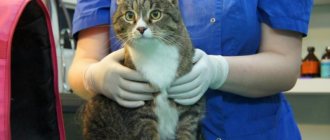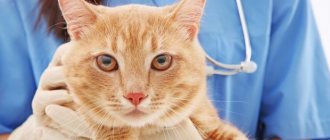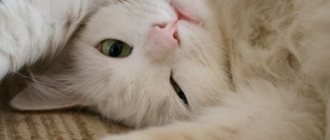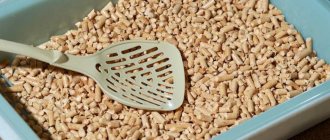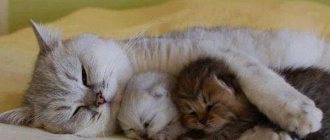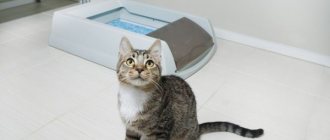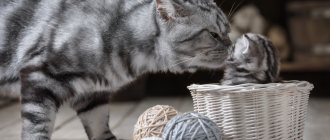Usually the sterilization operation goes well and without any consequences. But there are times when an animal has problems that they are not able to tell a person about. This is why it is very important to monitor your cat after surgery. What to do if your pet doesn’t go to the toilet? Perhaps something went wrong and she needs your help? Everything is exactly like that! We will discuss how to help the animal later in the article.
How long can a cat normally go to the toilet after sterilization?
When an animal goes to the toilet you need to be extremely careful.
At this time, there should be either light or white litter in the tray. This is necessary in order to notice the first drops of blood. For care during this period, it is better to take a soft absorbent, this will help avoid irritation. After castration, some owners have adapted to putting on a small diaper for their pet, in which they previously made a hole for the tail. There are often cases when a pet does not go to the toilet for a long time, either in a small way or in a big way. This is very worrying for the owner. In this case, you can give him Vaseline oil to drink. This will help him with the toilet. Urine may come out in small portions, literally drop by drop. At first this is normal. A month after castration, his urine will not have such a strong odor as before.
Reference!
Every cat is different and sometimes the fact that she doesn’t go to the toilet doesn’t mean anything bad. It will take a little time and everything will happen by itself, but it’s still better to keep your eyes open.
Doesn't pee
After anesthesia, all processes in the animal’s body slow down and, accordingly, going to the toilet may be delayed. However, if the cat does not urinate the next day after sterilization, then it needs the help of a veterinarian.
If the cat has returned to a normal rhythm of life, eats and drinks, but does not go to the toilet, it is possible that she has developed inflammation of the genitourinary system.
This occurs when the ureters become swollen and urine cannot pass out.
Doesn't poop
If a cat does not have bowel movements for less than three days, then there is nothing wrong with this and there is no need to sound the alarm. However, the absence of bowel movements for more than three days is a reason to start worrying.
What can a veterinarian advise?
Content
Causes
Although sterilization is considered a simple operation, every cat has health characteristics. The veterinarian conducts a conversation with the owners before the operation, and afterward explains the specifics of caring for it and prescribes the necessary medications. You should listen carefully to the specialist who performed the operation. Some advice you can get from your doctor:
- Be prepared for the fact that your cat may behave strangely after waking up from anesthesia. She is lost in space, can stagger, fall, meow and hiss. Observe the animal at first so that it does not involuntarily harm itself.
- You need to be prepared for the fact that the cat may wet itself, and may even vomit.
- Do not disturb the cat after surgery, provide it with peace and quiet. There is no need to try to feed the cat the first day after surgery. Drinking is allowed after 3-4 hours.
Just in case, you should take the phone number of the doctor who performed the operation. If you have any difficulties with your cat’s behavior or the condition of its stitches, it is better to immediately contact a specialist by phone.
Caring for a cat in the first postoperative hours
After the operation, the cat will be very weak for the first three hours. He will experience dizziness, nausea, thirst, and muscle weakness. This is a normal condition that should not bother the owner, so the pet will recover from anesthesia.
The owner may be offered to leave the pet on the first day at the clinic, under the supervision of a doctor, but he will be there in a stressful state. Therefore, it is better to take him home so that the cat feels the care and participation of the owner.
During the postoperative period, the cat experiences:
- Dry eyes. During anesthesia, cats' eyes do not close, they remain open. During the operation, the veterinarian closes the animal's eyelids from time to time so that the conjunctiva is moistened with tears. If the cat has not yet recovered from anesthesia, then the owner will have to do this.
- In order to properly care for your pet's eyes, you need to buy tetracycline eye ointment or antiseptic drops. After the pet has recovered from anesthesia, there is no need to close his eyes; he will do this on his own. There are times when an animal lies for a long time with its eyes open, then it is necessary to drip saline solution into the eyes. This will save them from dryness.
- Low body temperature. The usual cat temperature is 37.5 – 39.0 degrees Celsius. In the postoperative period, the temperature can drop to 36.5 - 37.0 degrees. The cat should be placed on a warm bedding and covered with a warm blanket. In extreme cases, the cat can be warmed with a heating pad. To normalize blood circulation, he needs to rub his ears and paws.
- Unsteady gait. This is due to the relaxation of muscles during the application of anesthesia. Usually during this period the cat walks with a staggering gait. On the first day, you should better monitor your pet so that he does not climb to any height, otherwise he may not be able to hold on and fall.
- At first, the cat needs painkillers. If your pet is silent, this does not mean that he does not feel pain. Most animals silently endure pain. They completely refuse food and are in a motionless position. Their pupils, as a rule, are dilated and concentrated. The gaze is fixed on one point.
READ Interesting facts about swans – a selection of photos
What is castration?
Although it is generally accepted that this term refers exclusively to the surgical removal of the testes, in fact this is not entirely true.
“Castration” itself is the suppression of the sexual function of an animal, and for this it is not at all necessary to remove the gonads.
Today there are the following types of sterilization that are actively used in practice:
- Surgical castration. The most common option. Involves surgical excision of the testes.
- Radiation. The gonads are irradiated under a directed source of gamma radiation. The glandular tissue that makes up the testicles is very sensitive to radiation. Its cells quickly die and are subsequently replaced by connective tissue. The cat's libido, accordingly, drops.
- Chemical castration. With this method, chemicals are introduced directly into the tissue of the testes, promoting tissue degradation and “drying out” of the organs. This technique is not very common in our country, but in Asian countries where it is widely practiced, a 10% calcium chloride solution is used for this purpose.
- Medical castration. In this case, a cartridge with special medications is sewn under the cat’s skin. Gradually released into the general bloodstream of the animal, they suppress its sexual function. The advantage of this type of castration is not only its simplicity. When the medicine in the cartridge runs out, the pet's libido gradually returns. So this method can be used for temporary castration. This is relevant, for example, for cat owners who often travel abroad with their pet.
To understand what exactly can cause a cat’s inappropriate behavior after the procedure and what to do about it, you need to have at least an approximate idea of exactly how it is carried out.
Adequate reasons for “delays” of the trip
So, the anesthesia has passed, but the pain syndrome remains, which each animal perceives differently. Some lead normal lives, eat and drink, while others lie indifferently and refuse food and water. In this case, the cat simply will have nothing to go to the toilet with.
What to do? You can try giving the cat water from a syringe (without a needle). Don't worry about it being harmful.
Excess fluid will be released along with urine, and you will help the animal’s body escape from dehydration and start normal life processes.
Another reason for delayed bowel movements may be the blanket worn after surgery.
Many animals feel uncomfortable in any clothing and, having freed themselves from it, immediately run to the toilet. However, in this case, you cannot leave the cat alone and make sure that she does not start licking the seam.
After all the necessary tasks, be sure to put the blanket back on. Veterinarians do not recommend this method and say not to remove the blanket for a week to avoid serious complications.
Attention!
Sometimes, after surgery, animals walk in a small way unnoticed, wearing a diaper and a little at a time. This is a normal reaction to surgery and there is no reason to worry.
If no dangerous symptoms are observed, the cat eats and even goes to the tray in a small way, but does not get ready to go in a big way, while meowing and straining, then she needs help!
To get rid of reflex constipation and cause a trip to the toilet, it is usually enough to feed the animal with liquid food, broth and give the pet laxatives.
Important!
Only a veterinarian can prescribe a laxative to an animal! Do not self-medicate under any circumstances.
The only safe and harmless remedy for your pet is a light tummy massage, but only with the approval of the cat. If she doesn't mind, then you can stroke your belly in a circular motion.
Laxatives
Microlax enemas are widely used for our little brothers. The product is not dangerous for a small organism, because it is not absorbed by the intestinal walls and is not digested.
READ Why does a cat have trouble walking with his hind legs?
For a cat, half the contents of one enema is enough, but only a doctor can prescribe the exact dosage based on the clinical picture.
The drug "Duphalac" is aimed at normalizing the functioning of the stomach and gastrointestinal tract as a whole. The product is effective and does not cause harm.
The advantage of this product is that it starts to act very quickly. The veterinarian will prescribe the dose required for the animal. To offer a cure, it is best to mix the syrup or powder with the animal's favorite food.
The drug "Lactusan" is a pribiotic and is used to treat constipation in cats. It comes in many forms: tablets, suspensions and syrups. "Lactusan" has a laxative effect and makes it easier to go to the toilet. It can be given with food or dissolved in water. Use with fermented milk products is not recommended.
Petrolatum
Vaseline is a natural remedy for constipation. You need to use pharmaceutical vaseline oil.
It does not have the ability to be absorbed into the body, it perfectly softens the intestinal walls and feces, which, after using the product, are easily passed out.
Despite the many advantages of the drug and its harmlessness, you should consult a doctor before use.
Typically, the prescribed dose of petroleum jelly is 0.5 milliliters. You need to drink this amount of oil every few hours.
In addition, there are suppositories based on petrolatum oil, which are widely used for constipation in cats. One candle for a cat will be too much, which is why it needs to be cut in half.
You can try making an enema of pure water using petroleum jelly. It has an enveloping effect and soothes. After the enema, defecation occurs approximately two hours later.
Norms of urination in cats and cats
Fluid volume in animals usually varies from 50 to 200 milliliters per day. But this figure depends on several indicators. This includes:
For example, a small kitten up to 2-3 months is unlikely to make large puddles. And an adult cat of 3-4 years old can get half of the tray dirty from one trip to the toilet.
What to do if the litter box is clean, but the cat is behaving too unusually
Newborn kittens can pee once a day, and up to 3 months old - up to 2-3 times a day. This is difficult to track if the animal is not litter box trained. Sometimes even babies at 4 months pee only once a day, this is also a normal case.
Attention! This should not happen in adult animals. If the cat cannot pee more than once a day, then you need to look for the reason.
Urination may differ only slightly between male and female cats. In cats, the urethra is thinner but longer. The outflow will be different - up to 5 times a day, regardless of whether he is neutered or not. Females will go to the tray up to 3 times a day, provided they have normal, nutritious food.
Variant of normal behavior of a cat
Treatment of the wound
The groin area should be examined daily and checked for bleeding. Also:
- To help the sutures heal better, they are treated with hydrogen peroxide and brilliant green twice a day.
- You can lubricate the suture area with Levomekol ointment.
- During the rehabilitation period, your cat should be wearing a collar that will prevent the animal from licking the wound. Licking the wound can lead to sutures coming apart and, consequently, infection. During care, it is removed only during feeding.
The rehabilitation period is easier in winter. If the operation was performed in the summer, a five-day course of antibiotic therapy may be required. It is better to play it safe than to treat the resulting infection later.
Treatment and prevention
If your cat has any digestive problems caused by a lack of dietary fiber in the diet, Duphalac will help cope with them. This is a lactulose solution. It is not digested and is not excreted from the body with milk. In addition, adding a small amount of pumpkin puree to the food helps.
There are also special commercial feeds designed to enhance peristalsis in animals that have given birth. In severe cases, an enema in combination with abdominal massage can be used for immediate evacuation of feces. If constipation is caused by bones getting into the digestive tract, it can only be treated through complex abdominal surgery.
The sooner the predisposing factors are neutralized, the faster the animal’s intestinal motility will improve. In particular, if your pet is a representative of long-haired breeds, brush it more often, as otherwise all the hair will end up in its intestines. Make sure your animal always has unlimited access to clean drinking water. In addition, you do not need to give your cat dry food for at least 5 days after birth.
Dangerous conditions or complications
Attention!
The first few days after sterilization, it is necessary to monitor the animal’s condition very carefully. The best way out of the situation would be to leave the cat under the supervision of veterinarians.
If the cat remains at home, then you need to monitor her very carefully and immediately contact the clinic in case of alarming symptoms:
- inability to go to the toilet three days after surgery;
- severe bleeding of the suture;
- an increase in body temperature (above 39 degrees) or a strong decrease (below 37 degrees) after a few days;
- swelling of the suture or its suppuration;
- depressed state of the animal;
- refusal of food and water even several days after sterilization;
- pale color of mucous membranes;
- abdominal pain and severe bloating.
What might the symptoms indicate?
- Pale mucous membranes in an animal may be a sign of internal bleeding.
- Symptoms may indicate that your cat has had a volvulus.
- Another complication is intestinal obstruction.
- The inflammatory process at the site of the suture can also cause complications.
READ How to determine if a pig is pregnant and how long does a pregnant pig walk?
Important!
If you notice any symptoms, do not delay and take the cat to the veterinary clinic, because she needs urgent help!
If a cat has diarrhea, then a completely different approach to solving the problem is needed. Recognizing diarrhea is not at all difficult, because its main difference is liquid feces.
If your pet has diarrhea, you need to take it to the veterinarian. He will measure the animal’s body temperature, determine the degree of dehydration, and palpate the tummy and internal organs. In addition, the clinic will perform some tests:
- examination of urine and feces (for the presence of worms, for hidden bleeding);
- blood analysis.
Treatment for the disorder will depend on its severity, duration and, most importantly, the cause of its occurrence.
In some cases, it is enough to provide the cat with rest and keep it on a starvation diet for one day.
If a cat experiences fluid loss, it must be replenished through intravenous drips or oral administration. When feeding, you need to follow a diet, and the portion of food should increase gradually.
If diarrhea is a consequence of an infection introduced during sterilization, then in addition to all the above actions, special treatment is also included, which is prescribed by the doctor.
If the following symptoms are detected while caring for your cat, you should immediately contact a veterinarian:
- Heartbeat disturbance.
- Breathing disorders. The appearance of wheezing during breathing.
- Swelling of the tongue or eyelids.
- Excessive pallor or brightness of the mucous membranes.
One of the important factors is to provide the pet with complete peace, silence, and isolation from other animals during care. Carefully take care of the wound and the toilet, and then he will quickly recover and will delight you with an attractive and healthy appearance.
We process postoperative sutures
Immediately after sterilization, ichor and a small amount of blood will be released from the suture. Small bruises and bruises may appear on the skin near the suture - this is a natural process after surgery. The seam itself looks like a red roller, rising above the level of the skin. Surgical threads may also be visible from it. Immediately after arriving home, it is recommended to apply ice wrapped in a clean scarf to the seam.
After 2 days after sterilization, the seam must be treated with disinfectants. A solution of chlorhexidine or miramistin is suitable. Using a cotton swab soaked in the solution, you need to carefully treat the seam area, clean it of dirt and hair. Attention! To avoid burns, it is forbidden to use iodine and brilliant green!
The approximate course of treatment of a postoperative scar after sterilization is 10 days. Treatment frequency: 2 times a day. If after 5 days the seam is still wet and inflamed, then you should immediately seek help from a veterinarian - it is often necessary to additionally treat the cat’s stomach with an antibacterial ointment, for example, levomekol.
Animal food
In the first postoperative hours, your pet's appetite will be reduced; there is no need to force-feed the cat. It's okay if your pet doesn't eat on the first day. The care required is the availability of water. It must be in sufficient quantity.
After castration, the animal’s interests change; it switches from cats to food. The cat is constantly hungry. He shouldn’t indulge him in this. It must be remembered that a neutered cat has a risk of developing urolithiasis. Components such as phosphorus, magnesium and calcium can lead to this disease. When caring for a cat, in order to avoid this disease, you need to completely exclude fish, as it is rich in these elements.
Veterinarians recommend that after castration, feed the animal dry food, which acidifies urine and is a prevention of urolithiasis. A pet who eats dry food must drink more fluids, otherwise he will have difficulty going to the toilet. To one part dry food there should be three parts water. If he rarely goes to the toilet for a little while, then you should contact the veterinarian, he will prescribe diuretics.
A neutered pet constantly begs for food, but this does not mean that he is hungry. You should not follow his lead, otherwise obesity may develop.
Reasons why a cat cannot pee or only walks a little
A representative of the cat family should not be allowed to go to the litter box less than twice a day. This is a situation that requires the intervention of the owner if it lasts longer than one day and the cat does not leave the house.
It is important to understand that this is a dangerous situation that cannot be ignored. Insufficient bladder emptying can lead to serious problems.
Why can't a cat pee:
- urolithiasis disease;
- inflammatory processes in the urinary system;
- kidney diseases;
- cystitis;
- congenital pathologies;
- overexcitation in uncastrated animals;
- mechanical blockage/obstruction.
Attention! If you had to castrate or sterilize a cat, you need to monitor the food and diet. Poor quality feed and large amounts of dairy products can lead to the rapid development of urolithiasis.
Disturbing animal pose
Household reasons
If a cat cannot go to the toilet, then this may have a simple reason - overstimulation. In this case, secretion begins from the gonads, they increase in size and close the urinary ducts. Sometimes, due to overstimulation, a plug of discharge appears in the urethral canal.
A common occurrence is cystitis. In its standard course, the animal will simply urinate frequently. But sometimes the urethral canal can be so blocked by inflammation that the cat cannot pee at all. If the excretory tracts are too swollen, the throughput will be reduced to a minimum. It is necessary to treat this disease; complete blockage should not be allowed, this leads to serious complications and deterioration of well-being.
Even a simple household injury - an unsuccessful jump or fall - can lead to difficulty urinating. At night, cats like to lie down on the walkways - the owner could simply not notice the animal and step on it. If a cat cannot pee after an injury, this is a reason to urgently contact a veterinarian and provide first aid to the animal.
Unusual animal behavior
Kidney diseases
This cannot be determined at home; you need to contact a specialist. Only a veterinarian can detect the presence of a disease or developmental pathology. Among the indirect signs of the presence of the disease:
- nervous or noticeably passive state;
- elastic belly;
- the animal does not lie down on its stomach;
- blood in urine;
- the cat is lethargic, tired;
- elevated temperature;
- the animal walks past the tray.
Important! In this case, only a doctor can prescribe treatment. There is no need to try to treat a cat on your own, without visiting a doctor, if it has blood in its urine.
Urolithiasis disease
A disease that can only be diagnosed by a specialist. It is more likely to affect animals that have undergone sterilization or castration, as well as animals with a poor diet. If the cat eats cheap food with a large proportion of grains, or drinks a lot of milk, this can trigger the onset of the disease.
During the development of the disease, stones, salt or sand gradually form in the excretory canals. They affect the functioning of the bladder, and the cat will not be able to force itself to pee due to pain. In later stages, the passage may become clogged with foreign bodies. This leads to inflammation and rupture of internal organs due to the accumulation of urine there.
Particularly susceptible to the development of urolithiasis are overweight cats that are reluctant to move and lead a sedentary lifestyle.
The cat fits into the tray
Note! Without treatment, the cat will not be able to pee, this can lead to bleeding and death of the animal.
When should you call a veterinarian?
But still, in some cases, you need to immediately call a veterinary specialist, even if no more than a day has passed since the operation.
Let us describe the most “good” reasons for this:
- If 10-12 hours have already passed since the procedure, but the cat has not recovered from anesthesia. It’s not at all good when your pet’s skin becomes cool and his breathing becomes rare and intermittent. Such signs very “transparently” hint at complications after anesthesia.
- When and after recovery from anesthesia, the cat does not show any interest in water and food for 24 hours. It is not at all good if an animal drinks but does not pee after castration. Such symptoms indicate bladder atony. If nothing is done (do not insert a catheter, for example), the walls of the organ will eventually not withstand the pressure of the fluid. The cat will die from internal bleeding. A painful, tense abdominal wall also indicates problems with the bladder.
- If within three days after the operation the cat still does not lose weight. This indicates intestinal obstruction or atony. When the pet also eats, everything is not good at all. Semi-digested food masses accumulate in the intestinal lumen, become compacted and rot. This can lead to both systemic intoxication and gastrointestinal diseases.
We invite you to read: Balinese life in the rhythm of legong
In all of the above cases, your pet most likely requires immediate veterinary attention. There is no need to let things take their course, hoping that everything will “resolve” on its own - the cat can easily die from a ruptured bladder or severe intoxication.
